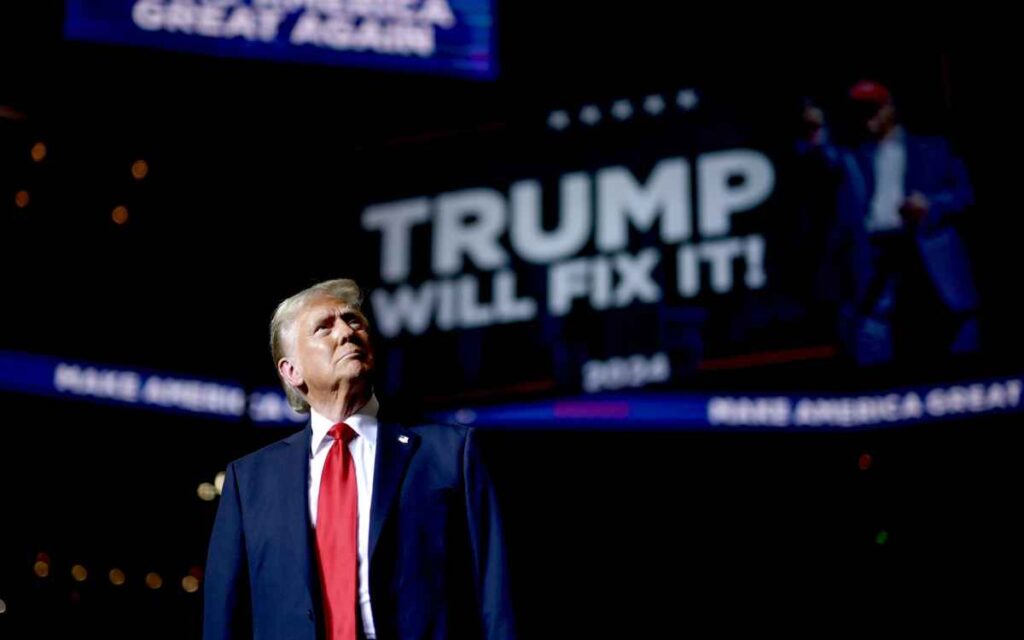
The steps are clear and ordered. America has no excuse for lawlessness or ignorance regarding what happens in the weeks ahead. Pictured: U.S. President-Elect Donald Trump. Photo Credit: Donald Trump/X.
With voters in the United States having elected President-Elect Donald Trump as President Joe Biden’s successor, an election timeline can be chronicled. There are several dates to keep in mind as the process unfolds. Early voting began in September, but what to expect during this timeframe may help some people better understand the steps.
The 2024 US Presidential election was largely determined on Nov. 5 and Nov. 6, with some results bleeding over the following days. Fortunately, the wait was not lengthy. I recall being up until about 3:30 a.m. election night in 1976 waiting for the call that projected Jimmy Carter as the next president. In 1980 the networks already knew Ronald Reagan had defeated Carter by about 8:15 p.m. The 2000 election swung back and forth and then sat undeclared until December 13 when a court ruling finally ended the counting in Florida and gave the election to George W. Bush. Most are familiar with the 2016 and 2020 denials, charges, and counter-charges that led to where we are today. While I would not have been surprised if either side had prolonged or protested the result, Trump’s clear victory spared the nation a divisive period. A specific calendar of dates will follow. I will include dates that have passed as instruction and a prologue to what happens next.
PRE-ELECTION PREPARATIONS
Every state government administers the election in their jurisdiction. New York state, for example, began early voting on Oct. 26 and continued through Nov.3. Oct. 26 was the last day a person could register to vote in the 2024 election. Texas, however, marked the final day to register as Oct. 7 and began early voting on Oct. 21 in person. The last day to apply for a mail-in ballot was Oct. 25 and the final day to vote early was Nov. 1. Keeping track of these dates and procedures can be difficult if you don’t use the websites available.
State officials mail out reminders and plenty of public service announcements are broadcast to remind people of the times, the options, and the locations for voting. Having looked at these sites and seen some of the literature provided I believe the claims of voter fraud by the Trumpsters and voter suppression by the Democrats have been exaggerated, partisan, and a distraction from the story of how the greatest democracy in history elects a new President, Congress, and Senate every four years. Every state oversaw similar dates and times, ensured those eligible to vote could be registered, double-checked information and lists, hired people to set up polls, organized the ballots, and kept them safe. The idea that fraud is widespread, or people are trying to prevent those of a specific race from voting, seems unlikely. The amount of security, checks, and oversight makes American elections as free, fair, and legitimate as any place in the world.
ELECTION DAY
Nov. 5, 2024, represented the Super Bowl of the election season. Since a presidential election occurs every four years, it may be more accurate to compare it to the Olympics. As with early voting, the hours that polls are open vary from state to state. In Kentucky, they opened at 6:00 a.m. and closed at 6:00 p.m. If you were in line at 6:00 p.m. you were allowed to vote. The polls opened at 7:00 a.m. in California and closed at 8:00 p.m. Considering the difference in hours, television and cable have to be prepared to begin reporting results at 6:00 p.m. and expect results to flood in until at least 11:00 p.m. and later. In a close election, viewers may have to watch for hours and wait until the wee hours of the morning to know the winner.
If the counting gets delayed the problems are compounded and the results can be set back for days. In most states, the threshold for a recount is a 0.5 per cent difference. According to the National Conference of States Legislatures (NCSL) website, “The laws governing recounts vary by state. In 24 states and Washington, D.C., recounts are automatically triggered if results are within a certain margin. In 41 states and Washington, D.C., a recount can be requested. In states that do not offer a recount process, a defeated candidate’s only remedy is to contest the result of the election in court, and recounts may be ordered by a court.” The site also indicates that “Twenty-four states and Washington, D.C., provide for automatic or mandatory recounts, which are conducted if the margin between the top two candidates is within certain parameters. The threshold to trigger an automatic recount ranges from a margin of 1% to only in the case of a tie vote. The most common trigger is 0.5%.”
If the election had reflected the polls the chances of recounts occurring in a few states could have hindered any candidate from accumulating the 270 electoral votes needed to win. As it turned out, Trump’s victories were substantial enough that no state recounts at the presidential level were required. When Trump appeared to have secured the magic 270 the networks or media companies slowly projected him as the winner. The number crunching that goes on at that level stifles the mind. The statisticians, data gurus, and legal minds required to make that decision include some of the brightest thinkers in America. As bad as the pre-election polling became, the in-house election call left no doubt and produced no mistakes. Trump secured a strong and durable victory.
CERTIFICATION IN THE STATES AND CONGRESS
The declaration of a winner moves the process to certification within each state and in Congress. Both sides hired legal teams to fight irregularities, charges of suppression and fraud, or ineligible ballots in preparation for a long fight but that will not be necessary this time. Republicans and the Trump Team are infamous for rejecting the results in 2020, but the stakes seem to rise in every election and Democrats now believe they must fight fire with fire. The Department of Justice challenged Virginia, Georgia, and Alabama’s efforts to get their voter lists in order before the election. The following press release described the DOJ’s actions in Virginia, “On October 11th, the Justice Department announced it had filed a suit against the State of Virginia, Virginia Board of Elections and Virginia Commissioner of Elections to challenge a systematic state program aimed at removing voters from its election rolls too close to the Nov. 5 general election…” Governor Glen Youngkin of the Old Dominion argued that the state government must fulfill its role and ensure the accuracy of voter rolls. In an age of litigiousness following the law also has its risks.
Regardless, each state’s Secretary of State must certify the election for their state. The period provided for certification ranges from one day to thirty days but involves a careful reporting procedure filled with a series of checks. Cybersecurity protections exist and legal warrants have to be signed attesting to the accuracy and truthfulness of the information. If anyone believes that election cheating bears no consequence that would be naive. Jail terms and fines are a strong deterrent. I encourage any readers thinking that cheating occurs habitually and unnoticed to study the following government document: https://www.eac.gov/election-officials/election-results-canvass-and-certification
Once elections are certified the process moves to the next big date in December. At least six days before electors vote to confirm the results, “Your State’s Executive prepares seven Certificates of Ascertainment. Immediately after the election results in your State are certified, the Executive sends one of those original Certificates of Ascertainment to the Archivist.” (National Archives https://www.archives.gov/electoral-college/key-dates).
On Dec. 17 the electors vote in their state: “The electors meet in their respective States and vote for President and Vice President on separate ballots. The electors record their votes on six Certificates of Vote, which are paired with the six remaining Certificates of Ascertainment. The electors sign, seal up, and certify six sets of electoral votes. A set of electoral votes consists of one Certificate of Ascertainment and one Certificate of Vote.” By the fourth Wednesday in December (Dec. 25, 2024) these votes must arrive in Washington where the President of the Senate and the Archivist receive them. The new Congress is sworn in and by Jan. 3, 2025, the Archivist transmits sets of the certified results to Congress.
On Jan. 6, 2025, the following should occur peacefully and orderly. First, the Vice President, as President of the Senate, presides over the count and announces the results of the vote. Second, objections can be raised but one-fifth of the senators and representatives must sign a written statement. There are only two objections: i) that the electors of the State were not lawfully certified under a Certificate of Ascertainment, ii) or that the vote of one or more electors has not been regularly given. Members would retreat to their chambers to decide upon the merits of the grievance. Third, if no candidate receives 270 electoral votes the 12th Amendment to the Constitution instructs members how to proceed. Simply stated, “If no presidential candidate has a majority vote, or if there is a tie, the House of Representatives chooses who will be the president. The Senate goes through the same procedure for choosing the vice president if there is a tie or if no candidate gets a majority.”
The steps are clear and ordered. America has no excuse for lawlessness or ignorance regarding what happens in the weeks ahead. Propriety has triumphed so far. Trump won a fair and free election and Vice-President Kamala Harris congratulated him, conceded defeat. On Jan. 20, 2025, this will all culminate in the united and majestic power transfer to the newly elected president. What could go wrong?

Dave Redekop is a retired elementary resource teacher who worked part-time at the St. Catharines Courthouse as a Registrar until being appointed Executive Director at Redeemer Bible Church in October 2023. He has worked on political campaigns since high school and attended university in South Carolina for five years, earning a Master’s in American History with a specialization in Civil Rights. Dave loves reading biographies.




















